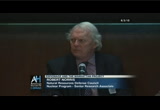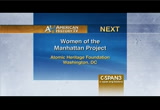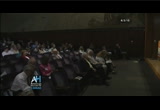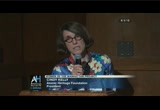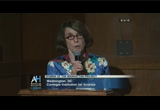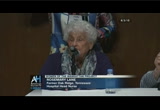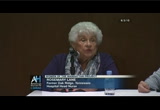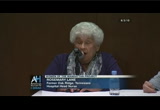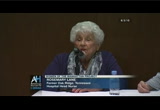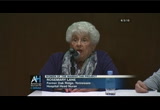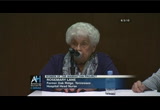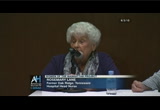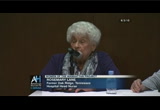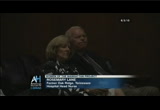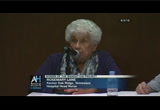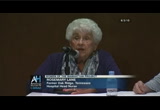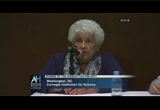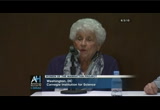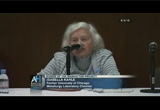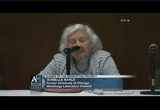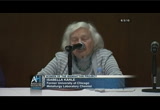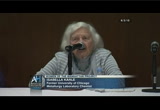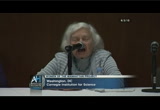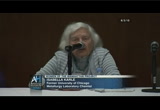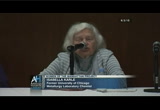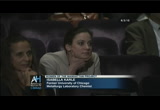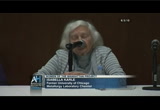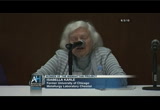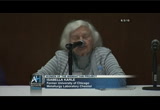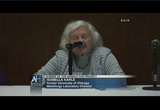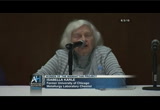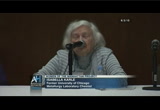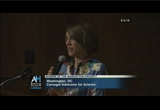tv Discussion on Women of the Manhattan Project CSPAN July 4, 2015 5:53am-6:32am EDT
5:53 am
more difficult to get into. mark cramer tells me that and others who try and do research in russia. and there was an opportunity when yeltsin was around when you could walk in the archives and find out all kinds of important things about soviet history and russian history. >> is there some desperate question? nobody is desperate. we're going to have anot
5:54 am
symposium hosted by the atomic heritage symposium. this is 40 minutes. >> i hope you've enjoyed the morning program. we're now in for some additional treats this afternoon. this section is called girls of the manhattan project, and i sadly had to -- i'm not sad about filling in but i'm sad that denise kiernen who is the author of "girls of the atomic city" will not be here today. so i know many of you are
5:55 am
looking forward to her. she's just a wonderful, vivacious, engaging person and just fell in love with oak ridge and the girls that she met there and that are the heroines of her book. her book reached "new york times" best seller list when it came out and it fascinated people with a story of the women in world war ii who were working on this top secret project in oak ridge. and one of the girls -- she featured nine girls -- is with us this afternoon and that's rosemary meyers lane. three of them are captured -- three of the girls that are the nine major characters -- not characters but people she focused on in her book are on our voices of the manhattan project website. we were able to take interviews
5:56 am
with them so you can read the book and then listen and hear them on our website. colleen black is one i would like to remember who is in her book and a very, very dear enthusiast for preserving oak ridge's history and the creation of the national park. sadly, she passed away in the last couple of months, but she's just larger than life. she arrived in oak ridge with her extended family of ten persons and they lived in a trailer and worked in shifts so they could sleep in shifts, could all fit into the trailer. but she never talked about it without just exuding enthusiasm. she'll be missed.
5:57 am
another person that is focused in the book is katie strickland. she came from auburn, alabama, with her husband to work at the k-25 only to discover that the army's segregation policies for bid her from living with her husband. so she had to drivebribe the military police with homemade biscuits in order to have a rendezvous with him. the book is full of great stories. kind of like the stories we've been hearing yesterday and today. so one of the themes when i talked to denise about what she might like to talk about today is about the journey that each of these women took that was representative of the transformation going on in u.s. society with respect to women and the world of work.
5:58 am
it came from, you know, this necessity that there were huge manufacturing plants and manufacturing jobs that had to be filled by women because the men were off to war, but it really was an incredible impact on the united states and world society to suddenly open up all these opportunities to women. so, without further adieu i have two such samples right here. rosemary lane who was a nurse at oak ridge and isabella carle who was a chemist at the met lab in chicago. so first i'm going to ask rosemary to tell us a little bit about her story and how her experience on the manhattan project transformed her life. >> well -- >> the problem we have is this
5:59 am
mic needs to be about two inches from your lips. >> oh. well i got to oak ridge -- >> is that working? >> can you hear me? >> here we go. now it's on. go ahead. can we dim the lights a little bit? it's blinding up here. that's better, thank you. >> much better, thank you. >> mic? >> now it's off again? >> no. >> i came to oak ridge in august of 1943. i was a new -- relatively new graduate from nursing school. i graduated one year ahead of that time and i had been
6:00 am
working -- continuing to work at the hospital that i had finished my training in and then had -- was going to school part time and i got a phone call one day, and it was a former instructor of mine. and she said, oh i've got something to talk to you about. i'd like to meet you for lunch, which we did. she, it turned out had become a recruiter for the manhattan project for nurses because they were getting ready -- she was going to help staff a hospital that was in the process of being built. this is in august of '43. the hospital was still not built, but she was looking for people to work there and offered me -- gave me a very nice opportunity to be -- to go down and actually be a charge nurse at the emergency room of the hospital. well i was seriously becoming a member of the army or the navy as many of my friends had done right at the height of the war. many had gone into the service.
6:01 am
i decided, well, i think so. she assured me i would be serving my country and doing as great a good as i could at any military installation or any branch of the service and i did still have the opportunity that if i didn't like it, i could come home. i thought that was a pretty good deal to at least try, which i did. so i arrived the 15th of august, 1943 on a very very hot, sunny afternoon. met at the train in knoxville. another girl nurse who had graduated with me, we had also had the same opportunity to go to oak ridge. she was going to work in the o.b. department. so she came to the train to meet me with a friend. on to oak ridge. lived in a dormitory. there were only two dormitories for women and i think two or three for men at that time. it was a very, very hot day. no roads. no sidewalks. one cafeteria and about three
6:02 am
dormitories was where all the people who came to oak ridge from away from that area lived in single rooms or double rooms. we actually were in single rooms. i shared a room with rose basinsky was her name at that time. anyway, that's how i got to oak ridge. the hospital was still not built. actually, it was not built until -- completed until november. it was in the process. november it was finished, and it was a 50-bed hospital. and i was in charge of the emergency room, helped set it up. we were a very very very busy emergency room. that was the only medical place. we lived in the town of oak ridge. this did not serve the people who worked there during the day when they were at work, there were medical facilities out at
6:03 am
the plant sites but the people who lived in the town which at that time was mostly the families of people who were building and many of the scientists that were working out at the lab and they would go by bus out to their work sites during the day but then come back to the city -- to oak ridge. so we not only took care of emergency -- what an ordinary emergency room does taking care of emergencies, we were the medical -- only medical center in the area except for knoxville, which was 20 miles away. so it was a very, very busy place. we saw a lot of not only emergencies but sore throats strep throats as young families moved in ear aches and all the things that go with raising a family because the houses were being built very quickly very fast. comments would be made on the way to would. when i went out to work the street was completely filled.
6:04 am
there were 20 houses by the end of the day within that same area. and it's just by leaps and bounds. it was exciting. and i lived in this dormitory. it was hot. we all ate at the central cafeteria. there was also a recreation center in the town center which was available for us to meet. they had music and it was a place for -- of course almost all of the people there were young. most were unmarried, and they were from all over the united states. people from california to minnesota, new york, texas. you name it, it was just -- there were no -- and of course, you know locals were actually in any of the dorms as well. as a general rule, most of the people i worked with the whole time i was there were not natives. they were from somewhere else.
6:05 am
and when the hospital finished and, you know it was staffed by physicians who were all in the military. colonel ray was the director of the hospital and there were about, oh, i guess, 15 doctors from the university of minnesota, maybe not quite that many, who initially staffed the hospital. well shortly after the hospital was built they started an addition. they knew it wasn't large enough. they added an out-patient department and staffed it with all -- within months there were doctors from every specialty heading by departments the out-patient department, and with it my job grew. i went from just being in the emergency room to being in charge of the out-patient department and helping to set up the protocol and the standing
6:06 am
orders and so forth equipment, the staff, the people who were working in that clinic. it was pediatrics, obg, all of the clinics you would have, ent. you name it those services were all available to people, but none of the nurses were military, but all the physicians were. they were captains and colonels and so forth. and they all had their families. they moved to oak ridge and they were there by the time i got there. they occupied the first so-called permanent type houses. there were a lot of other different types of temporary housing in the oak ridge area that was occupied by people who were the workers primarily. big companies that were doing all the building and doing the roads. there were no roads and sidewalks. there was lots and lots of mud but it was a lot of fun. met a lot of nice people and had
6:07 am
a lot of good times. and so anyway, that's where we were and that's where -- it was at a time when we saw as many as 1,000 patients in a day throughout the whole clinic. that's how busy it was. it was very challenging and very satisfying. you got to know lots of people from a lot of the country. anyway, as i said, after that we went to -- that was in 1943 and of course the war continued to stay very, very busy. we had some interesting incidents being a nurse. i lived in the nurse -- started in the dormitory then moved to the house that was built for nurses only. it was a dormitory, which was right next door to the hospital and lived there for a while. and we outgrew that. so one day colonel ray asked me
6:08 am
if i wouldn't mind moving to an apartment which was this close to the hospital because they needed more space in the dorm and so they could add more -- put an addition on. we were getting -- we were allowed to go to some of the apartments that people were occupying. so i shared an apartment with the chief dietician of the hospital. it was right next door to -- so it was easy to go to work but we had a bedroom a living room and a little kitchen. so it was a very nice experience. well, i enjoyed that for, oh, i guess probably six or eight -- about eight months and got another phone call from colonel ray and asked -- and told me that i'd have to move out of my dorm and i'd have to go back to the -- i'd have to go back to the dorm because they needed my apartment because there was some man out of y-12 which was one of the areas that had become mentally deranged and that because he was such a high security risk, he could not be removed from oak ridge that
6:09 am
they would have to find a place for him to stay and be treated at that place so they did build out of my apartment. there was a guard with him all the time. they barred all the windows in the place. that's where he did stay. we did have a psychiatric department at the clinic as well, and that's where -- and he was being treated until they said he could never be removed from there until the war was over because he had too much information that could be very harmful because he spoke too much about what he did out at one of the plants. so that was a nice experience and not so nice when i had to go back to the dorms but it was one of the things that happened in oak ridge. in 1945 the war was over and none of us knew. everybody was so conscious of the fact that we were the big secret city.
6:10 am
they were about to send one to knoxville, that's when we could go to shop and everything. lots of posters and signs everywhere to encourage people to not talk, to not speak. you know leave any information you have where it is. you not discuss your job with anybody. and of course i was just a nurse -- i was a nurse in a hospital like any other city is what it amounted to but i was serving the families of the people who worked out at the plant areas but i didn't have secrets to any projects of any kind. it wasn't like i was a threat or could have been very much of a threat. i might have been able to hear something from someone else that you couldn't pass on to someone else. nobody could come visit you. you had to get a permit or a pass. and -- to come in to visit so you always -- nobody could drop by to see you.
6:11 am
in '45 the day the bomb was dropped, it was quite a memorable day as it was for many many people. the colonel told us all to meet in his office at 10:00 in the morning. so we -- all the staff everybody who could, not patients but those of us who worked there, and the president was on the radio. there was no tv at that time. and made the announcement that the bomb had been dropped on hiroshima and his comment was now you know what you've been doing here or what you've been helping to do. doing other phases of the work. and people worked around the clock at the plant sites so there were a lot of people working lots and lots of hours under lots of not such good
6:12 am
conditions many times. everybody seemed to be -- we had a very patriotic feel about them. you didn't hear much complaining except for the mud and the heat. these things are normal. when the war was over, all the military doctors went back to their cities of origin and set up their practices again. quite a number did stay in oak ridge and continued to stay in the clinics and continued practices because many people continued to stay in oak ridge because research was being done and although at one time there was 75,000 people living there, there were quite a few. i just was ready to go back to chicago and then i had an opportunity to work out at -- on the sites out in the area x-10 as an industrial nurse.
6:13 am
that was open 24 hours a day but i was a charge nurse for dr. feldman who was a director. while there i met my husband. he was a research assistant. he had a job as a research assistance. he had just returned from four years in the navy and needed some material one day and came to the health department or my department and come to find out we lived or grew up in little towns in iowa, and i mean very small towns, and had never met before. anyway, that was the beginning of a friendship and we got married about a year later. he continued to work there as a research assistant. went back to school and got his degree. he finished his degree. he left his internship. we married and lived there.
6:14 am
he went to work for the energy commission and when they were transferred up to washington, d.c., in 1958, our family moved up here. of course, we were sad, all of us. we had met so many nice people who had been -- gone through labor like our family. if all of your friends became your family, we celebrated holidays together. it was a wonderful great experience. i feel grateful to have had the opportunity to have worked there and it was just by chance but i did enjoy it. [ applause ] >> thank you very much. >> i went over. >> no it was excellent. isabella. we heard isabella yesterday for
6:15 am
those of you that were here but she's going to tell us her experiences at the met lab. >> i was a graduate student in 1943 and my husband of not too many months was also a graduate student, had deferred until he got his ph.d.. the day he got his ph.d. he also got a notice from his draft board he was now 1a material. and he was somewhat sad about this because once you got your ph.d., you had a certain dedication to the science, a lot of expenditure of energy and that
6:17 am
marched over to the laboratory and i was told that this was now my new bailiwick and that norman davidson who was running that particular laboratory would tell me what it was all about. only first i found out if i could by myself what it was all about. i think they were trying to see how secure their system was about the information about the
6:18 am
research that was going on in the building. well, it didn't take too long to find out that i was working on a new element, plutonium. and this new element needed to be explored as to its chemical properties. a man by the name of seborn was at the head of that particular laboratory laboratory. although i didn't see much of him on one or two occasions. it was only afterwards that i got to know him. in the laboratory i was escorted to i was told that there was a new element and the new element needed compounds made and they needed to have their chemical
6:19 am
properties evaluated and so that's how i met up with plutonium. we -- our group which consisted of about six people got our materials from oak ridge so we got plutonium in the form of plutonium oxide however, the purity was not as good as pure chemical compounds can be. and the interest was to make new compounds and to study the chemistry of the plutonium from a chemist's point of view. i soon found out that this was a heavy metal also that it would
6:20 am
take knowledge of inorganic chemistry to make the appropriate derivatives from it and as it happened in my degree work for a ph.d. in chemistry i never had any courses in heavy metal chemistry. that was another new point. in quite a hurry i had to find out how to make inorganic compounds, how to analyze them and in addition this one had very peculiar properties in that it had an extremely high melting point and i couldn't come up with anything. there was a whole new world in working with the plutonium and
6:21 am
trying to make compounds from it. i did succeed in making plutonium chloride in about six different ways, but this i didn't have and had to create by myself. i knew that it could be done in the vacuum line. i was familiar with vacuum lines, but i was not familiar with vacuum lines at high temperatures, and my vacuum lines were usually made of ordinary glass or pyrex glass because i had to work at temperatures near 8 or 900 degrees centigrade. fortunately, the stockroom at the university of chicago that we could use did have a lot of
6:22 am
pyr -- not pyrex sorry silica glass that was already in tubes of various sizes but in order to blow that glass -- i knew how to blow soft glass. i knew how to blow pyrex glass, but with this i had to use a torch that used hydrogen as the fuel fuel, and as many of you can imagine, a hydrogen flame is a pretty hot flame. it will melt things at 900 degrees. it will burn at 900 degrees and melt special glasses. some of the material i told you about yesterday in the
6:23 am
preliminary talk at this meeting. so i had to figure out how to handle the material to make a vacuum line with it working at the very high temperatures and blowing this particular glass required flames that gave off so much light that i had to use extra dark glasses that i couldn't see through unless i used a blowtorch that took advantage of hydrogen supply burned the hydrogen and to do the ordinary procedures one would ordinarily use to get that
6:24 am
into a vacuum line. unfortunately, we didn't have a pump to evacuate the vacuum lines that was sufficiently good good. i began to make new compounds from the plutonium that was sent to us from oak ridge. every week there would be a delivery, usually at the end of the week, of a new batch of plutonium oxide which was relatively pure but not chemically pure and pick out pieces of the plutonium oxide and react them with heir large
6:25 am
number of organic compounds that contained the chloride or the chlorine atom. i was successful in synthesizeing plutonium chloride under many different conditions. the point being to see what range of chloride compounds i could make. they all turned out to be the same no matter what chloride source was. from that point i was able to continue the work in growing beautiful dark green crystals, gem quality.
6:26 am
and it was a bit boring bass theecause the inorganic chloride i used made the same kind of crystals and they were, indeed the same material. it was all very constant. all plutonium chloride which was then tested by x-ray defraction by poif zacchariason who was a permanent faculty member of the physics department and he, indeed, figured out through x-ray diffraction that there was nothing other than plutonium chloride and it was all the same crystal class. i had experiences in carrying
6:27 am
this determine around in my pocket because that was the easiest way to get past the security guard with no problem. our chemistry building we were in a building called new chemistry. that no longer exists. it was dismantled some years ago. we would go along city blocks to the physics department with professor zacchariason had his permanent laboratory. that was fine until the security people found out what i was doing, and then i had two guards, one on either side walking with me always dressed in uniform so that everybody who looked it would have seemed there was something peculiar about me.
6:28 am
other than the job becoming somewhat monotonous because all i was making was plutonium chloride under very many different laboratory conditions and i was beginning to be quite good at it the other people around me were making plutonium bromide, and that made nice crystals too. plutonium fluoride which caused some disastrous conditions in that plutonium fluoride turned out to be a vapor, a gas, not a solid and our laboratory was filled with it so it had to be removed by vigorous ventilation
6:29 am
of the laboratory, and you know where that plutonium fluoride compounds went, you know, right out into the air, into the neighborhood houses nearby. but supposedly it was diluted sufficiently so nobody complained about any peculiar health effects, at least not at that time. another member of our group was making plutonium -- or trying to make plutonium iodide, and that was not quite as successful in making nice crystals. i suppose a side of me plutonium, there's a large side of me, bromide presented very good crystallization.
6:30 am
and then there were those who were trying to made plutonium plouride, and that was a disaster. it all went up into the air. it wasn't a solid. so the whole laboratory was shut down for a while until it was well ventilated well aired out i guess, to the benefit of all the neighbors who were living nearby and didn't know what was happening to them. but we didn't hear about any bad results in the future. so my experiences in chicago could be condensed to the making of the plutonium chloride in many different ways. i don't know what the material was used for afterwards.
6:31 am
thank you. [ applause ] >> i want to pursue questions, but i'm anxious to get the next panel here so we can make sure that we're on time for the other speakers who are coming, but we really appreciate the wonderful and diverse stories of rosemary and isabella, who are just two of the many women who found themselves working on the manhattan
43 Views
IN COLLECTIONS
CSPAN3 Television Archive
Television Archive  Television Archive News Search Service
Television Archive News Search Service 
Uploaded by TV Archive on

 Live Music Archive
Live Music Archive Librivox Free Audio
Librivox Free Audio Metropolitan Museum
Metropolitan Museum Cleveland Museum of Art
Cleveland Museum of Art Internet Arcade
Internet Arcade Console Living Room
Console Living Room Books to Borrow
Books to Borrow Open Library
Open Library TV News
TV News Understanding 9/11
Understanding 9/11